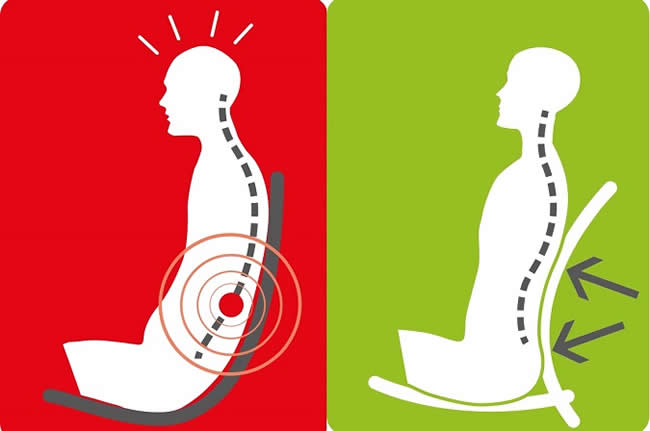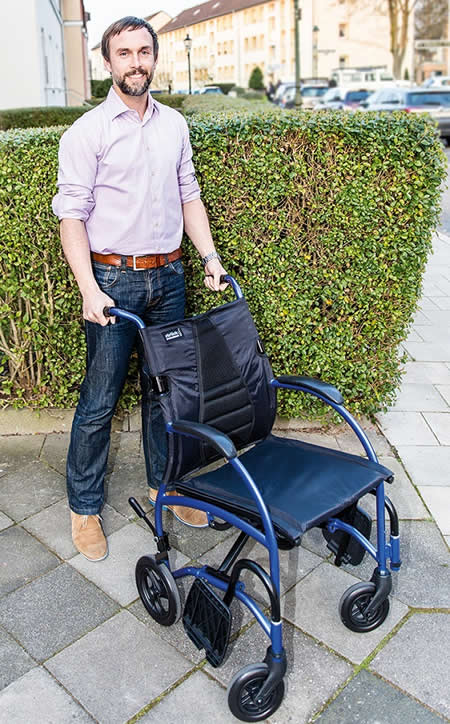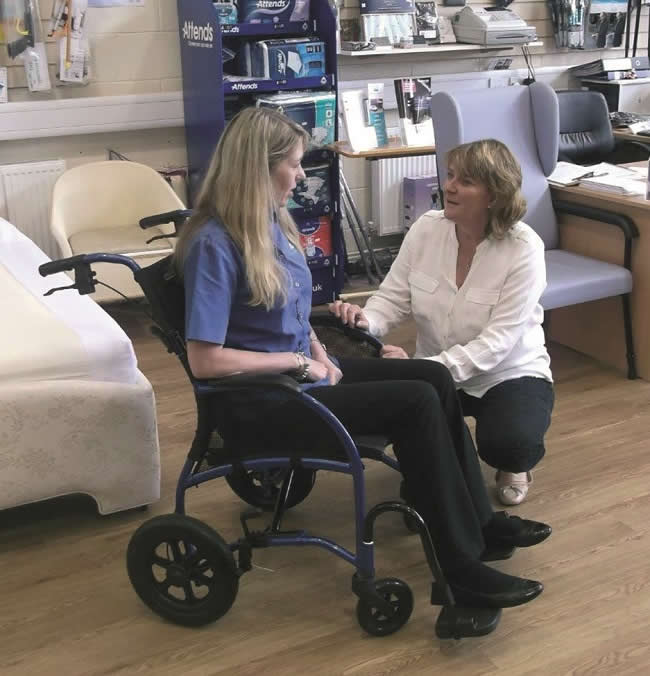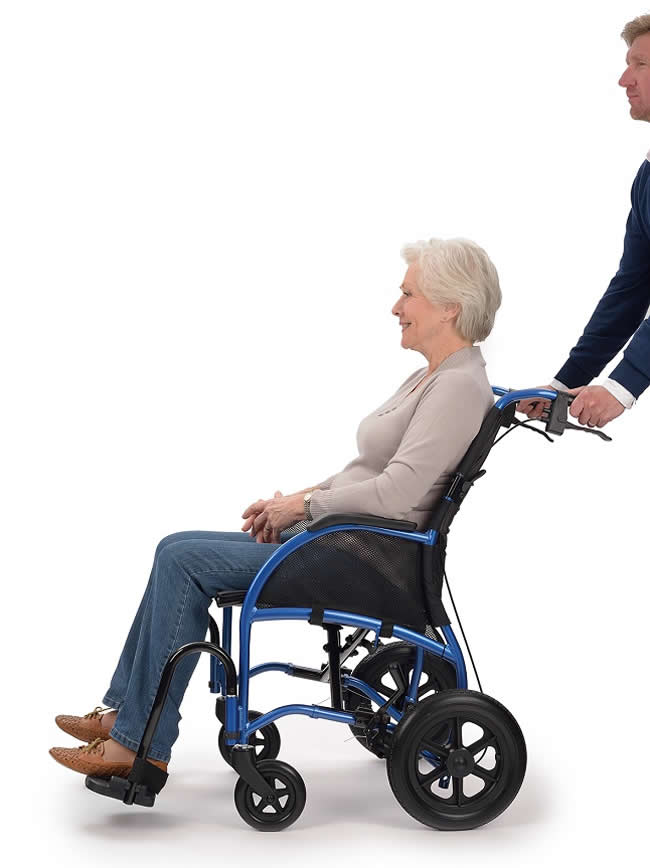Positive Health Online
Your Country

Promoting Healthy Posture for Wheelchair Users
listed in back pain, originally published in issue 235 - January 2017
Introduction
The provision of an appropriate and supportive wheelchair will enable good posture with head, spinal and trunk support and pelvic alignment. This is essential for regular or permanent wheelchair users to facilitate better occupation and well-being through reduced discomfort, back pain or fatigue. However many traditional wheelchairs do not promote good posture and lack appropriate lumbar support which can lead to chronic pain or long term health problems. This article discusses the importance of good posture, appropriate lumbar support and how an example wheelchair design, the TGA Strongback, may provide occupant benefits through a considered ergonomic backrest.

The Definition of Posture
“Posture is a term that indicates the relative position of the body segments during rest or activity” Twomey and Taylor (1987).[1] “Sitting” is a posture where weight is transferred to the seat of a chair or wheelchair through the Ischial Tuberosities and surroundings soft tissue of the buttocks and thighs. Depending on the wheelchair design, weight is also transferred through the backrest and armrests.
In the context of this article seated posture is as stated in Seeking the optimal posture of the seated lumbar spine, Dr Jennifer Pynt et al. (2001):[2] : “Seated posture is defined according to the effect of sitting on the lumbar spine curvature. A flex seated posture is one that reverses the individual’s standing (normally lordotic) lumber curve into a Kyphotic position (forward slouching / backwards slumping). A lordotic or extended seated posture is one that maintains the lumbar curve close to that of an individual’s lordotic standing position (upright/slight rear recline).”
Hence good postural health and reduced discomfort arises from maintenance of lordosis, interspersed with movement - achievable with a wheelchair that incorporates an ergonomically curved backrest and frame as opposed to a traditional upright backrest.
Many Traditional Wheelchairs Promote Poor Posture
Frequent wheelchair users can experience multiple problems associated with poor posture. Without appropriate lateral and backrest support, an occupant’s spine may not achieve a natural position resulting in several issues associated with:
- Reduced Occupational Performance;
- Back pain and increased fatigue;
- Detrimental affects on internal organ function;
- Decreased communication;
- Difficulties with breathing, eating and drinking;
- Increased risk of spasm;
- Musculoskeletal deformities such as Kyphosis and Scoliosis;
- Developing Pressure areas.
Spinal Cord Injury Peer Support Group, Apparelyzed, provides a useful summary explaining why poor posture is common with users of badly designed wheelchairs and illustrates the resultant problems. “To feel more comfortable or stable, many wheelchair users slump back and slide the buttocks forward in the seat. This type of posture results in a very stable sitting position, but increases the risk of developing posture-related health problems. Bad posture can result in reduced lung capacity, back and neck pain, and pressure ulcers. These are some of the most common postural related complaints amongst wheelchair users.”[3]
“Bad posture and seating of an individual in a wheelchair often leads to musculoskeletal changes over time. If the wheelchair user is not sitting in a correct position, changes to the skeletal system can take place over a number of years, putting additional strain on the spinal column and limbs. These changes alter the efficiency of muscle groups increasing the stress on them resulting in joint and muscle pain.”[3]
Preventing Back Pain Through The Lordosed Sitting Posture
There is a variety of evidence to suggest that sitting in a lordotic posture reduces the possibility of many health issues and back pain. It is important to note that pain arising from poor seated posture is insidious and that a wheelchair user’s healthy back may not register pain until irreversible problems such as Intervertebral Disc Degeneration (IVD) has occurred. Therefore it is essential that a well-designed wheelchair is provided in the early stages of a user’s requirement and that teaching of healthy seated posture is both preventive and therapeutic.
Hedman and Fernie, (1997)[4] also reported benefits of sitting in a sustained lordosis lumbar position compared with cyphered postures. They discovered that:
- The compressive forces in discs were reduced;
- Disc shear force was decreased by 75%;
- A balancing of forces in Zygapophysial joints;
As a definition, Zygapophysial joints (also known as facet joints or z-joints) are located on the posterior of the spine on each side where two adjacent vertebrae meet. The facet joints provide stability and permit the spine to bend and twist. The joint contains cartilage between bones and is surrounded by a sac-like capsule that is filled with synovial fluid;[5]
If a regular or sustained kyphotic sitting position occured, there was a:
- 9% increase in disc shear force;
- Large increases in the tensile forces around the posterior annulus;
- Greater, unbalanced anterior forces in the Zygapophysial joints;
- Three times the level of force in the posterior ligament on the flexed position than occurred in the anterior ligament in the extended position.
Hedman and Fernie (1997)[4] referred to the results of the aggregate posterior ligament and force exaction that occur from loading in the flexed posture as “alarming” in terms of potential damage to the posterior ligament and disc. Therefore it can be concluded that the potential for IVD and lower back pain is increased when a cyphered (bending forward) sitting position is achieved.
Pynt et al. (2001)[2] in summary suggests: “Sustained lorded sitting posture (healthy upright posture with natural spinal curvature) decreases disc pressure and thereby disc degeneration, exhibits less injurious levels of ligament tension and although it may increase Zygapophysial loading, this is not of itself considered hazardous to spinal health. A sustained cyphered sitting posture (bent, hunched over), on the other hand, increases Intradiscal pressure leading to increased fluid loss, decreased nutrition and altered cell synthesis and biomechanics of the disc, appearing to culminate ultimately in disc degeneration that is a cause of low back pain.
The Importance of an Ergonomic Wheelchair Backrest
A curved convex wheelchair backrest that has been carefully considered in terms of appropriate ergonomics will provide more effective lumbar support and encourage a lordotic or extended seated posture. However the angle and curvature of the backrest must be carefully considered to ensure Hyperlordosis does not occur. Andersson et al, (1975)[6] demonstrated that: “if the lumbar support is placed at the level of the sacrum it will have the effect of forcing the buttocks forward, creating lumbar Kyphosis.” Further, it was the opinion of Pynt et al. (2001)[2] that the apex of the lumbar support is placed so as to maintain the lordosis but not at end of range extension, and such a placement creates pain-free and relaxed position; this will be the optimal location for lumbar support of the seated individual.
Postural health and reduced pain is more achievable if the lumbar support is appropriate to the degree of individual lordosis. This avoids holding the lumbar spine in sustained hyperlordosis, which causes vertical compression of the Zygapophysial joints and may impinge on the lamina of the vertebra below Bogduk and Twomey, (1987),[7] causing pain. The depth of the lumbar support may therefore need to be adjustable to accommodate individual lordosis.
Sue Hall Head of Physiotherapy and Karen Marshall, Wheelchair and Seating Department Manager at The Royal Hospital for Neuro Disability also state that: “The surface on which the body is resting has an effect on comfort and position - if it is contoured to the shape of the body it will be more comfortable than a flat surface and will distribute the weight more evenly.”[8]
Maintaining Lordosis Through Exemplary Wheelchair Design
To eliminate the posterior rotation of the pelvis and concomitant flattening of the lumbar spine, the angle between the hip and the trunk needs to be increased Keegan (1953),[9] thus a greater reduction in hip flexion may be achieve by assuming a semi-lying position. Pynt et al. (2001)[2]also reiterated the findings of Andresson et al. (1975)[6]that for tasks not involving a forward posture, such as sitting in a wheelchair, it has been shown when a lumbar support of 4cm depth is used in conjunction with a reclined backrest of 130 degrees, lumbar lordosis is restored close to that of standing i.e. intradiscal pressure is decreased approximately 6% compared with erect sitting without lumbar support. Therefore, a supported ‘rear arched’ spinal position approximately 10% less than full extension can assist with better postural health.

This concept has been taken into consideration and applied in the design of a recently introduced wheelchair known as the TGA StrongBack in the UK. This Swiss ‘Strück’ product invented by Dr Christian Grothe and Ladd Lougee supports a healthy seated posture. Three years of joint product development have resulted in an ergonomic wheelchair that incorporates a convex curved backrest to support natural lumbar lordosis. It is suitable for a wide range of extended sitting postures with minimal adjustment and includes seating material that supports tissue viability.
Grothe has a PhD in Engineering and has primarily worked in the field of Aviation research; however following several years working in community equipment services across Europe, he has gained first-hand knowledge regarding the pain and discomfort associated with many conventional wheelchairs. Grothe comments: “With traditional vertical backrests, users always slump in their wheelchair and adopt an unhealthy seated position. This is because the conventional wheelchair geometry makes effortless upright sitting impossible.” The folding StrongBack employs an effective, ergonomic curved lumbar support that is integrated into the frame. It provides a standard, non-bespoke wheelchair that does not require additional postural supports in many circumstances so that optimum lumbar support and comfort is provided for a wide range of occupants.

Lougee also states in summary that: “We know that many people suffer from backache in their traditional wheelchair due to poor ergonomics. The lightweight, folding StrongBack has a backrest that is geometrically more in-keeping with the natural curvature of the spine so extended periods of sitting will not result in chronic pain or other associated health and well-being problems. Added to this, firm yet appropriate lateral support will keep the pelvis mid-line so spinal curvature can be prevented in both planes. The importance of a well-fitting wheelchair is a vital consideration to maximize users Occupational Performance. Through evaluation of clinical evidence, considered R&D and end user testing we have been able to develop a wheelchair that will provide better lumbar support, better posture and a better quality of life.”

Conclusion
Promoting Occupational Performance is important to a wheelchair user to ensure they have a good quality of life and maintain their wellbeing and confidence. This is achieved through being able to perform every day activities with independence and ease from an appropriate and well-designed wheelchair. Using a wheelchair that has effective lumbar support and promotes healthy posture can produce a significant improvement in Occupational Performance.
Further Information
Further information and resources regarding all aspects of healthy choices for wheelchair users may be found at www.rksot.co.uk www.tgamobility.co.uk
References
1. Stockwell CW. Cited in: Twomey L, Taylor JR. Lumbar posture, movement and mechanics. In: Physical Therapy of the Low Back. Churchill Livingstone. 1987.
2. Pynt J, Higgs J & and Mackey, M. Physiotherapy Theory and Practice: An International Journal of Physical Therapy – Seeking the optimal posture of the seated lumbar spine. Taylor & Francis. 2001.
3. http://www.apparelyzed.com/musculoskeletal-pain.html . 2015.
4. Hedman T & Fernie G. Mechanical response of the lumbar spine to seated postural loads. Spine. p734-43. 1997.
5. DeMicco r. http://www.knowyourback.org. 2009.
6. Andersson G, Murphy R, Örtengren R & Nachemson AL. The influence of backrest inclination and lumbar support on lumbar lordosis. Spine. p 52-8. 1979
7. Bogduk N & Twomey L. Clinical Anatomy of the Lumbar Spine. Churchill Livingstone. 1987.
8. Marshall, K & Hall, S. A Beginner’s Guide to Postural Management. Quoting Engstrom B et al (2002) , Ford P (2004) Cooper RA (1998) Ham R et al 1998. Royal Hospital for Neuro Disability. 2012
9. Keegan J. Alteration of the lumbar curve related to posture and seating. Journal of Bone and Joint Surgery. 35A p582-603. 1953.
Bibliography
Twoney L & Taylor JR. The lumbar spine: structure, function, age changes and physiotherapy. Australian Journal of Physiotherapy. 40th Jubilee Issue. 1994.
Muscular Dystrophy UK via NICE National Institute for Health and Care Excellence. Wheelchair Provision for Children and Adults with Muscular Dystrophy and other Neuromuscular Conditions Best Practice Guidelines. March 2011.
Comments:
-
No Article Comments available